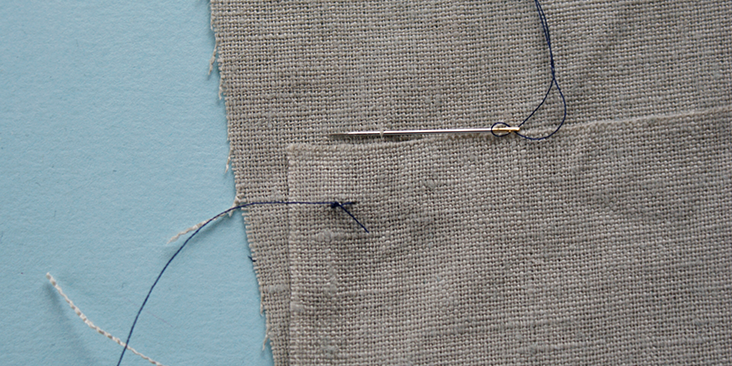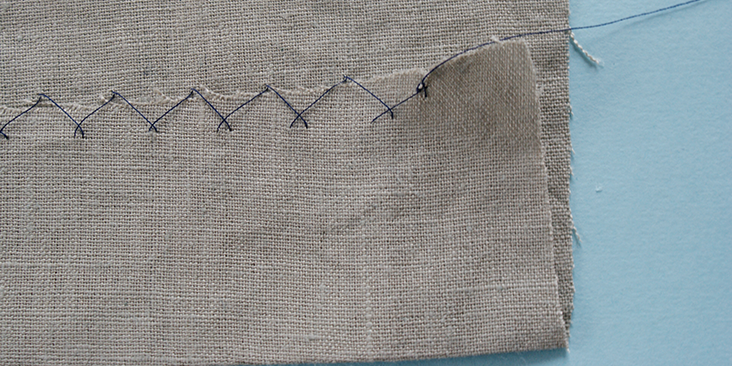How to do a catch stitch
Catch Stitch’ is a great stitch to know to add a professional finishing touch to your project. It is a favourite of mine because it is difficult to sew on too tight and therefore least likely to pucker the hem. Although this stitch method might take longer than the machine hemming method; with practice, this can be more’ accurate and you are in better control with the sewing. There is a reason why they only hand stitch hems in couture.
This stitch is great for hemming trousers and skirts. But it works well for all types of hems.
Tools
Fabric
Sewing thread
Sewing needle
Scissors
Iron
Step
1. Iron the fabric, after folding the given seam allowance towards the wrong side of the fabric.
2. Thread the needle on the fold, close to its edge and tie a knot. This is to prevent the knot coming loose, on the loosely woven linen fabric.
3. Pick up a thread of linen from the fabric on the main part of the fabric, slightly to the right side above the knot. Turn the fabric around’ to make sure the stitch isn’t showing on the right side. Choosing a matching colour thread will make this easier.
4. Then, again slightly to the right, continue the stitch on the fold of the fabric. When you are sewing along the seam allowance, it is ok to stitch normally as the sewing will not be seen.
5. When you reach the end of the fabric, tie a knot with the thread on the folded part of the fabric.
6. Turn around the fabric and check the stitch is invisible.
And now you can browse our Gallery of Fabrics‘ to inspire’ a new project to trial your new skills with.
Leave a comment Cancel reply
Related posts
An Introduction to Common Crotch Adjustments
Recently, I drafted a pattern and made a toile of a pair of drop-crotch pants. When I tried them on, I straight away noticed (and felt) they weren’t quite right. The most obvious issue was that the back crotch felt tight and pulled uncomfortably, especially when bending over. Walking also felt a little restricted, with…
How to Thread a Sewing Machine: A Beginners Guide – Part 2
Now that we’ve covered the basics of threading a sewing machine in Part 1, let’s move on to some additional functions. In Part 2, I’ll show you how to change both the needle and the presser foot. I’ll also introduce the twin needle, and share some helpful troubleshooting tips for common issues that can happen when…
Made by Hand: Ellen Merchant’s Printed Textiles
One of Britain’s most exciting and adventurous textile and wallpaper designers working today, Ellen Merchant places traditional print processes and high-quality materials at the heart of her creative practice. Inspired by the Arts and Crafts emphasis on hand-made design over mass-produced goods, her work embraces traditional, hand-block printing techniques and features intricate, ornate, botanical designs…
How to Thread a Sewing Machine: A Beginners Guide – Part 1
Threading a sewing machine can feel a bit daunting at first, but it quickly becomes second nature after you’ve done it a couple of times. These days, I don’t even think about it—muscle memory just takes over. That said, writing this tutorial made me slow down and walk through each step more deliberately. It reminded…
SEW THIS LOOK
LATEST COMMENTS
- Tutorial: Block Printed Kitchen Towels
21 Feb 2023 @ 6:13 am by 33 Tea Towel Crafts - HelthDestiny - The Fabric of the Renaissance
01 Dec 2020 @ 1:00 am by Who Is The Patron Saint Of Sickness? Turning To St. Roch For Healing » SymbolofFaith.shop - How to Take Your Body Measurements: A Concise Guide
23 Jun 2024 @ 12:59 am by Fitness 101: How To Support Your Body Transformation For Better Appearances • The Havok Journal - Caring for Linen: How to Wash, Dry, Iron and Remove Stains
10 Sep 2020 @ 1:00 am by Lviefent Rust Zip Mini Dress Review: Casual Comfort & Style Explored - How to Pre-Wash Fabric: A Simple Guide
03 Nov 2024 @ 9:37 am by How to Make a Cloth Doll | Easy Steps (2025)



























































12 Comments
Catherine M
I’m curious, why is the hem allowance not turned under twice? Wouldn’t it fray if only the raw edge of the linen is turned up but not folded into the inside of the hem? If the edge were serged, this wouldn’t be an issue, but I’m thinking for hand-sewn only garment construction.
Cynthia Fong
Thank you for your comment. Ideally the raw edge would be treated (serged, folded, with binding tape) depending on the tutorial. We mostly wanted to show the method for handstitching the hem as a finishing option. However, for an hand sewn only garment, this seam would indeed be turned under twice.
Sally Williams
While I know you did use a contrasting color thread, I wish you would either use a more highly contrasting thread or else press the piece of fabric.
Cynthia Fong
Thank you for your comment. We will take in your feedback and make sure we do for future tutorials.
Gigi
Christine, I believe the stitch is called ‘herringbone’. It’s beautifully done, too: picking up only one thread per stitch takes some care (but is well worth it).
Lovely job on these tutorials! Please keep them coming.
Cynthia Fong
Thank you for your comment. Working with linen definitely makes this stitch easier as you see the thread of the fabric easier.
Joy Beeson
Every tutorial says “iron”, and every tutorial doesn’t. Crumpled fabric does not photograph well.
I never iron the finished product — get *enough* wrinkles and they cancel out; start with none and the creases are highlighted and pointed at — but I do press during construction so that I can see what I’m doing.
Cynthia Fong
Thank you for your comment. We will take in your suggestion and improve our future tutorials.
Janny
I think it’s great that you have tutorials like this. I just wish that you would take the extra minute or two to press, turn under the seam allowance, etc. before taking the photo. A picture is worth a thousand words.
Cynthia Fong
Thank you for your comment. we have taken your suggestion and will make sure to improve our future tutorials.
Christine
The stitch illustrated is not a blind hem. It is called a cross stitch. A true blind hem stitch cannot be seen from either side of the garment.
Cynthia Fong
Thank you for your comment. Apologies for our mistake. Illustrated is a catch stitch for an invisible hem on the right side.